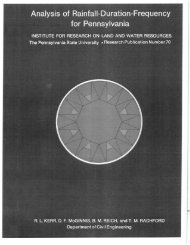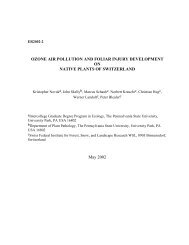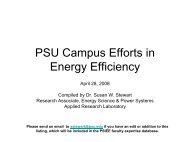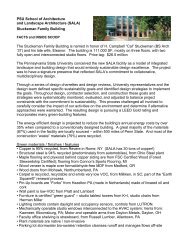Next-Generation Biofuels - Penn State Institutes of Energy and the ...
Next-Generation Biofuels - Penn State Institutes of Energy and the ...
Next-Generation Biofuels - Penn State Institutes of Energy and the ...
You also want an ePaper? Increase the reach of your titles
YUMPU automatically turns print PDFs into web optimized ePapers that Google loves.
18 NEXT-GENERATION BIOFUELS<br />
F O C U S<br />
Algae: Fuel <strong>of</strong> <strong>the</strong> Future?<br />
Dr. Jennie Hunter-Cevera, University <strong>of</strong> Maryl<strong>and</strong> Biotechnology Institute<br />
The Mid-Atlantic region is rich in water, sunlight <strong>and</strong> carbon dioxide. Unfortunately for <strong>the</strong> Chesapeake<br />
Bay, we are also rich in <strong>the</strong> capacity to grow algae. However, what has long been <strong>the</strong> bane <strong>of</strong> <strong>the</strong><br />
Bay may one day be an ally in its restoration. Scientists are investigating how algae-based bi<strong>of</strong>uel<br />
conversion systems may provide a significant opportunity for future fuel production, much like<br />
cellulosic bi<strong>of</strong>uel but with a greater yield.<br />
Research has demonstrated that bi<strong>of</strong>uels produced from algae could potentially supply enough fuel<br />
to meet all <strong>of</strong> America’s transportation needs by using a scant 0.2 percent <strong>of</strong> <strong>the</strong> nation’s l<strong>and</strong>, an area<br />
equivalent to that <strong>of</strong> Maryl<strong>and</strong>. Water, sunlight, nitrogen, phosphorus <strong>and</strong> carbon dioxide are <strong>the</strong> basic<br />
ingredients to grow algae. Demonstrations have shown that algae may double <strong>the</strong>ir volume overnight<br />
under optimal conditions <strong>and</strong> be harvested day after day. The oil produced by algae, up to 50 percent<br />
<strong>of</strong> <strong>the</strong>ir weight, can <strong>the</strong>n be harvested <strong>and</strong> converted into biodiesel. The algae’s carbohydrate content<br />
can be fermented into ethanol.<br />
Algae crops <strong>and</strong> conversion techniques may result in a cleaner-burning fuel than petroleum-based<br />
diesel or gas. It is conservatively estimated that a properly managed algae growing system could<br />
produce from 2,000 to upwards <strong>of</strong> 5,000 gallons <strong>of</strong> liquid fuels per acre per year. Current annual<br />
crop-based bi<strong>of</strong>uel production is approximately 20 gallons per acre from corn; 50 gallons per acre <strong>of</strong><br />
soybeans; 150 gallons per acre from canola; <strong>and</strong> 650 gallons per acre from palm.<br />
There are an estimated 65,000 to 100,000 known algae species. Hundreds <strong>of</strong> thous<strong>and</strong>s more species<br />
may still be identified <strong>and</strong> cultured. Algae do not require soil <strong>and</strong> can grow well in brackish water.<br />
In <strong>the</strong> desert southwest, where much <strong>of</strong> <strong>the</strong> groundwater is saline <strong>and</strong> unsuitable for o<strong>the</strong>r forms<br />
<strong>of</strong> agriculture, algae can proliferate. Algae require 1/100th <strong>of</strong> <strong>the</strong> water per acre compared to o<strong>the</strong>r<br />
crops, <strong>and</strong> <strong>the</strong> carbohydrate <strong>and</strong> protein elements can be used for o<strong>the</strong>r purposes including feed <strong>and</strong><br />
fertilizer. Algae are low maintenance <strong>and</strong> <strong>the</strong>ir ability to ingest carbon dioxide <strong>and</strong> excrete oxygen<br />
is attractive; it serves as an important means for mitigating <strong>the</strong> buildup <strong>of</strong> carbon dioxide in <strong>the</strong><br />
atmosphere due mainly to fossil fuel emissions.<br />
Using algae as an alternative fuel is not a new idea. Between 1978 <strong>and</strong> 1996, <strong>the</strong> U.S. Department <strong>of</strong><br />
<strong>Energy</strong> performed algal bi<strong>of</strong>uel research at <strong>the</strong>ir National Renewable <strong>Energy</strong> Laboratory in Golden,<br />
Colorado. Field trials with open ponds in California, New Mexico <strong>and</strong> even Hawaii were performed.<br />
Difficulties encountered included l<strong>and</strong> area requirements, evaporation <strong>of</strong> water <strong>and</strong> contamination by<br />
invasive plant species <strong>and</strong> o<strong>the</strong>r life forms in <strong>the</strong> ponds. Ultimately, <strong>the</strong> oil produced from algae was<br />
not economically competitive in 1996, when <strong>the</strong> price <strong>of</strong> a barrel <strong>of</strong> oil was $20.00.







